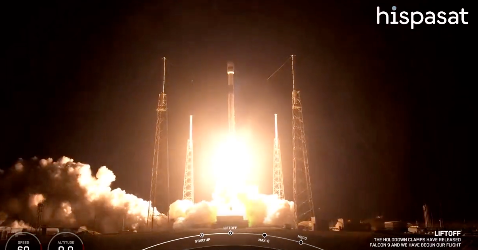Latest News

SpaceX launches the Amazonas Nexus satellite for Hispasat. Photo: SpaceX
SpaceX launched the Amazonas Nexus satellite for Spanish satellite operator Hispasat on Monday evening. The Falcon 9 mission took off from Space Launch Complex 40 at Cape Canaveral Space Force Station in Florida at 8:32 p.m. ET.
The satellite was deployed about 35 minutes into the mission, and Hispasat confirmed success after the launch.
The Amazonas Nexus satellite, built by Thales Alenia Space based on its Spacebus NEO platform, will replace Amazonas 2 in the 61 degrees West orbital position. It will cover all of the Americas, Greenland and the North and South Atlantic corridors, for connectivity services in remote areas and for mobility services for aviation and maritime. The satellite features a digital transparent processor (DTP) allowing Hispasat to reconfigure capacity to respond to changing market conditions. It is a Ku-band satellite, but it is also the first Hispasat satellite to also feature Ka-band capacity to optimize communications between the gateways and the satellite.
Hispasat has several long-term capacity agreements for 60% of the satellite’s capacity. The satellite also has a payload onboard called Greensat for Greenland’s state-owned communications company, Tele Greenland/Tusass to improve internet access in all remote towns and villages in Greenland. In addition, Anuvu has a deal for capacity for maritime connectivity.
This new satellite also incorporates for Artel the Pathfinder 2 mission of the U.S. Space Force, a high bandwidth protected communications transponder. The goal of the Space Force’s Pathfinder series is to demonstrate affordable bandwidth acquisition by gaining long-term access to transponder assets from commercial satellite providers.
“Amazonas Nexus ushers in a new stage. It will allow us to open new markets and fulfill our commitment to citizens to prevent the digital divide from continuing to grow and to provide them with access to digital rights, education and healthcare in remote locations. We would like to thank SpaceX, Thales Alenia Space and the entire Hispasat team for their work,” commented Hispasat President Jordi Hereu.
Hispasat is a regional satellite operator and a leader in distributing content in Spanish and Portuguese. Last year, Hispasat acquired Axess Networks, a teleport operator and satellite services provider with a presence in Latin America, Europe, the Middle East and Africa.
CEO Miguel Angel Panduro said in a recent interview with Via Satellite that the company has gotten closer to its end customers since acquiring Axess Networks. Panduro said the company would consider partnering with a third-party constellation in order to deploy its services.
“Regional operators have a characteristic that is unique: close relationships with local customers and a good understanding of their needs. That is something that global operators cannot offer. We care for our customers, and we provide the best-fit solution for their needs,” Panduro said.
Get the latest Via Satellite news!
Subscribe Now